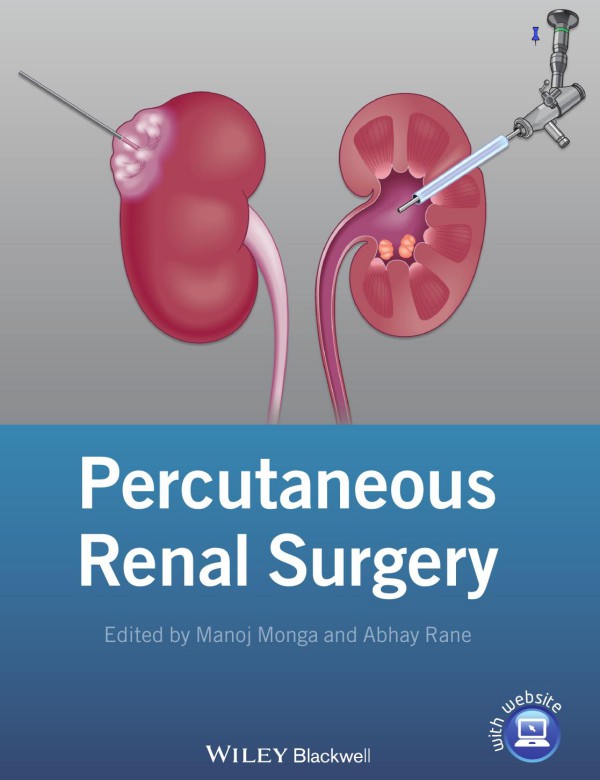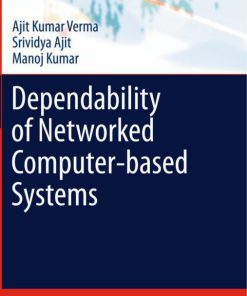Percutaneous Renal Surgery 1st Edition by Manoj Monga, Abhay Rane ISBN 1118670930 9781118670934
$50.00 Original price was: $50.00.$25.00Current price is: $25.00.
Authors:Rane, Abhay, Monga, Manoj , Author sort:Rane, Abhay, Monga, Manoj , Published:Published:Sep 2013
Percutaneous Renal Surgery 1st Edition by Manoj Monga, Abhay Rane – Ebook PDF Instant Download/Delivery. 1118670930, 9781118670934
Full download Percutaneous Renal Surgery 1st Edition after payment

Product details:
ISBN 10: 1118670930
ISBN 13: 9781118670934
Author: Manoj Monga, Abhay Rane
Percutaneous renal procedures are highly complex and require a great deal of surgical skill. Improve your patient care with this outstanding instruction manual from the experts. Clinically-focused throughout, the three major conditions managed by percutaneous renal surgery – large renal calculi, transitional cell cancer and renal cell cancer – are expertly covered by the world’s leading surgeons and urologists. Well-illustrated with over 100 top-quality surgical photos and with reference to the leading society guidelines in this area, inside you’ll find coverage of: • Evidence-based outcomes for percutaneous management • Patient selection and informed consent • Preparing the patient for surgery • Instrumentation used in surgery • Surgical technique and patient safety • Pre-and post-op counseling In addition, 10 high-quality videos offer an excellent visual guide to best practice and surgical tips and tricks of the trade. Percutaneous Renal Surgery is the perfect multi-media teaching tool, providing urologists, nephrologists and surgeons with the knowledge, confidence and clinical skills required to perform these complex and difficult surgical procedures safely and effectively.
Percutaneous Renal Surgery 1st Table of contents:
SECTION 1 Introduction
Chapter 1 Percutaneous Renal Access: A Historical Perspective
Introduction
History
Percutaneous nephrolithotomy
Percutaneous transitional cell carcinoma resection
Percutaneous endopyelotomy
Other applications
Conclusion
References
Chapter 2 Interventional Imaging and Radiation Safety
Introduction
Basic radiation physics
Percutaneous renal surgery for stones
Interventional imaging and radiation safety for upper tract transitional cell carcinoma
Interventional imaging and radiation safety for percutaneous renal mass ablation
Conclusion
References
SECTION 2 Percutaneous Management of Large Renal Calculi (Percutaneous Nephrolithotomy)
Chapter 3 Epidemiology of Large Renal Stones and Utilization Patterns of Percutaneous Nephrolithot
Introduction
The large renal stone
Trends in percutaneous nephrolithotomy utilization
Conclusion
References
Chapter 4 Evolution of Evidence-Based Outcomes for Percutaneous Nephrolithotomy
Introduction
Choice of treatment
Surgical planning
Postoperative considerations
References
Chapter 5 Patient Selection and Informed Consent
Patient selection
Informed consent
Conclusion
References
Chapter 6 Instrumentation and Surgical Technique: Percutaneous Access
Informed consent
Preoperative preparation
Patient positioning
Instrumentation
Step-by-step technique
Intraoperative trouble-shooting
Postoperative follow-up
References
Chapter 7 Instrumentation and Surgical Technique: Tract Dilation and Endoscopes
Upper tract dilation
Endoscopes
Conclusion
References
Chapter 8 Instrumentation and Surgical Technique: Intracorporeal Lithotrites
Introduction
Pneumatic lithotripters
Ultrasonic lithotripters
Dual ultrasonic and ballistic lithotripters
Electrohydraulic lithotripter
Holmium: YAG laser
Intraoperative trouble-shooting for rigid intracorporeal lithotripters
Conclusion
References
Chapter 9 Instrumentation and Surgical Technique: Step-by-Step Percutaneous Nephrolithotomy: Prone
Introduction
Informed consent
Preoperative preparation
Patient positioning
Instruments
Step-by-step technique
Intraoperative tips/trouble-shooting
Postoperative care
Conclusions
References
Chapter 10 Instrumentation and Surgical Technique: Step-by-Step Percutaneous Nephrolithotomy: Supine
Introduction
Indications for supine percutaneous nephrolithotomy
Informed consent
Instrumentation
Technique
Visceral injury in supine percutaneous nephrolithotomy
Supine percutaneous nephrolithotomy in special situations
Outcome for supine percutaneous nephrolithotomy
Conclusion
References
Chapter 11 Instrumentation and Surgical Technique: Step-by-Step Percutaneous Nephrolithotomy: Prone-
Patient positioning
Instrumentation
Step-by-step technique
Intraoperative trouble-shooting
References
Chapter 12 Instrumentation and Surgical Technique: Step-by-Step Percutaneous Nephrolithotomy: Endosc
Evolution of retrograde percutaneous access
Technique
Role in urological practice
Conclusion
References
Chapter 13 Instrumentation and Surgical Technique: Step-by-Step Percutaneous Nephrolithotomy: Mini-P
Introduction
Informed consent
Preoperative preparation
Patient positioning
Instrumentation
Step-by-step technique
Intraoperative trouble-shooting
Postoperative follow-up
References
Chapter 14 Instrumentation and Surgical Technique: Step-by-Step Percutaneous Nephrolithotomy: Multip
Introduction
Patient preparation
Informed consent
Instrumentation
Anesthesia
Step-by-step technique
Intraoperative trouble-shooting
Follow-up
References
Chapter 15 Instrumentation and Surgical Technique: Step-by-Step Percutaneous Nephrolithotomy: Tube o
Introduction
Definition of tubeless percutaneous nephrolithotomy
Advantages of tubeless versus standard percutaneous nephrolithotomy
Use of hemostatic agents in tubeless percutaneous nephrolithotomy
Supracostal access
Special considerations
Informed consent
Preoperative preparation
Patient positioning
Instrumentation
Step-by-step technique
Intraoperative trouble-shooting
Postoperative follow-up
Postoperative trouble-shooting/auxiliary procedures after tubeless percutaneous nephrolithotomy
Conclusion and recommendations
References
Chapter 16 Instrumentation and Surgical Technique: Postoperative Imaging Following Percutaneous Neph
Introduction
The importance of residual fragments
Diagnosis of residual fragments
Evaluation of hydrothorax
Additional considerations
References
Chapter 17 Instrumentation and Surgical Technique: Step-by-Step Antegrade Ureteric Stenting
Principles and prerequisites
Patient preparation
Equipment
Patient position
Analgesia and sedation
Technique
Rendezvous stenting
Special situations
Pitfalls and dangers
Conclusion
References
SECTION 3 Percutaneous Management of Transitional Cell Cancer (Percutaneous Resection of Tumor)
Chapter 18 Epidemiology of Disease (Upper Tract Transitional Cell Cancer)
Overall incidence and trend
Tumor location and stage at presentation
Age, sex, and race
Smoking and occupational exposure
Analgesic abuse
Other environmental risk factors
Hereditary cases of upper tract transitional cell carcinoma
Metachronous upper tract transitional cell carcinoma
Metachronous bladder transitional cell carcinoma
Prognosis
References
Chapter 19 Evidence-Based Outcomes for Percutaneous Management of Upper Tract Urothelial Carcinoma
References
Chapter 20 Patient Selection and Informed Consent
Introduction
Patient selection
Informed consent
Conclusion
References
Chapter 21 Percutaneous Treatment of Upper Tract Urothelial Carcinoma
Introduction
Indications
Techniques
Results
Conclusion
References
SECTION 4 Percutaneous Ablation of Renal Cell Cancer (Thermal and Nonthermal)
Chapter 22 Epidemiology and Biology of Small Renal Masses
Epidemiology of small renal masses
Tumor biology and natural history of small renal masses
Renal mass sampling
Functional impact of small renal mass treatment
Management of small renal masses and role of thermal ablation (Table 22.2)
Conclusion
References
Chapter 23 Evolution of Evidence-Based Outcomes for Percutaneous Management
Introduction
Oncological outcomes
Complications
Preservation of renal function
Length of hospital stay and postoperative convalescence
Cost-effectiveness
Alternative techniques
Conclusion
References
Chapter 24 Patient Selection and Informed Consent
Introduction
Patient selection
Informed consent
References
Chapter 25 Instrumentation and Technique: Cryotherapy
Introduction
Patient selection
Informed consent
Preoperative patient preparation
Principles of ablation
Patient positioning
Instrumentation
Step-by-step technique
Management of complications
Postoperative follow-up
Conclusion
References
Chapter 26 Instrumentation and Technique: Hyperthermal Ablation: Radiofrequency and Microwave Ablati
Introduction
History
How radiofrequency ablation works (Figure 26.2)
Radiofrequency blation
Microwave ablation
Future outlook
Conclusion
References
Chapter 27 Instrumentation and Technique: High-Intensity Focused Ultrasound
Introduction
Informed consent
Preoperative preparation
Patient positioning
Instrumentation
Step-by-step technique
Intraoperative trouble-shooting
Postoperative follow-up
Conclusion
References
Chapter 28 Instrumentation and Technique: Laser
Introduction
Laser technology for renal ablation
Experimental studies
Clinical studies
Conclusion
References
Chapter 29 Instrumentation and Technique: Irreversible Electroporation
Background and preclinical data
Clinical data
General surgical considerations
Instrumentation and technology
Informed consent
Positioning and step-by-step technique
Postoperative follow-up
References
Chapter 30 Instrumentation and Techniques in Renal Radiosurgery
Informed consent
Preoperative preparation
Patient positioning
Instrumentation
Step-by-step technique (Video Clip 30.1)
Intraoperative troubleshooting
Posttreatment follow-up
References
Chapter 31 Instrumentation and Technique: Renal Histotripsy
Controlled acoustic cavitation
Tissue homogenization
Ultrasound feedback
Histotripsy dose–bioeffect relationship
Histotripsy thresholds and renal structures
Hemostasis with histotripsy
Chronic histotripsy effects
Histotripsy of malignant tissue
People also search for Percutaneous Renal Surgery 1st:
percutaneous nephrostomy vs ureteral stent
percutaneous cryoablation for renal cell carcinoma
percutaneous nephrostomy for kidney stones
percutaneous drainage of renal abscess
percutaneous aspiration of renal cyst
You may also like…
eBook PDF
Obstetrics by Ten Teachers 18th Edition by Ash Monga, Phil Baker ISBN 0340816651 9780340816653
eBook PDF
Vander’s Renal Physiology 7th Edition by Douglas Eaton, John Pooler ISBN 007161303X 9780071613033












